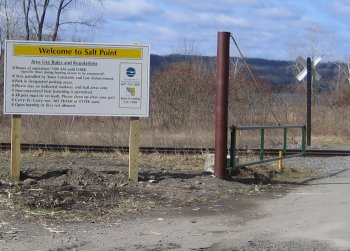- By Dan Veaner
- News
 Print
Print  Emily Powers
Emily PowersEmily Powers
Powers is a graduate student who is finishing her MA in Landscape Architecture at Cornell in the next few weeks. The Washington, DC native was enlisted by Town Envoronmental Planner Darby Kiley and Horticulture Professor Tom Whitlow to develop a planting strategy for the project. "This is a great, productive town-gown interaction," Kiley says. "She has been working with me and Tom Whitlow, who has been involved for quite a few years, and we've tried to find students to do things there."
Salt point becomes greener as more planting is implemented
and seed and pollen spreads across the park
Last month the Highway Department constructed a road and parking areas that will control public access and allow for non-motorized boat launching. But several old dirt roads that traverse the site have yet to be filled in or converted to walking trails. Power's plan involves planting flora that will spread over the site over a period of time. "Because we have limited resources, we will devote our energies into strategic areas of planting to provide seed dispersal by wind or animals or water that could bring more vegetation into the area, provide habitat and biodiversity," Powers said. "There are two weed populations that need to be managed on the site. To prevent new invasions we will combine a weed management strategy with our planting strategy."
She presented charts that show how the plantings would begin to cover the site over a four year period. The planting strategy will double to help fill in the dirt roads. "The idea is to use these areas of planting to prevent people using the old roads," she said. "It's deterrence as well as providing habitat for wildlife. We'll take existing car trails and turn them into pedestrian trails."
The plan identifies nodes of planting and a map for the kinds of plants that could be installed in them. Because the Town has limited resources for the project, it also calls for community involvement. "We'll try to get community sponsorship," Kiley explained. "Sponsors will help pay for plant materials and they'll gather volunteers to do some of the planting. It's a way to get the public involved in what's going on out there."

A new road and the first signs have already been installed. Increased
patrolling by Town Constable Scott Ferris has also been implemented.
The presentation also includes a time line that plots Salt Point history over the course of more than four million years. It lays out a four year plan for planting and the spread of the plants over the park. "Implementation will kick-off with an advertising campaign, community meetings, improved signage and increased police patrol," she writes. "Volunteer efforts will go a long way towards securing the success of Salt Point as a valuable historical and ecological park, and recreational, educational, and maintenance events will galvanize public support for this project."
Powers will finish her degree and move to New York City in three weeks, where she already has a job in landscape restoration lined up. "I'd ideally like to be doing this kind of work more than decorative planting," she says. "I'm interested in doing functional restoration. A lot of people have large acreage, and then they have wetlands on their property. They don't know what to do with it, so they can call us and we'll do an attractive wetlands restoration project for them."

She became interested in landscape architecture as a way to impact the environment. "I wanted to do something about the environment, but I didn't have the scientific background to do it," she says. "I was attracted to it as a way of doing applied ecology. I was also interested understanding what landscape means to people and how people deal with their surroundings."
The Salt Point project was a perfect match for Powers. Auditing Whitlow's restoration ecology class, she conducted soil tests at a number of sites, including Salt Point. When he learned of Power's interests he suggested she take on the planting plan as an independent study. "I was happy to do it and it's good experience," she says.
Powers says she would like to come back and see how her plan turns out. "Leaving is bittersweet," she says. "I like Salt Point a lot and I would like to come back to the area."
----
v3i19



